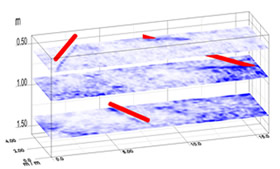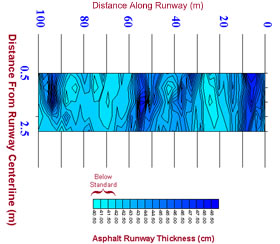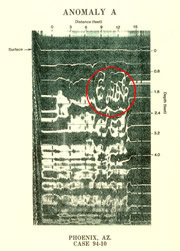SSS Online Interview
with Dennis Johnson, President of Geophysical Survey Systems, Inc. (GSSI)
April 2002
by Karen Edwards, Pegasus
Consulting Corporation
After reading the letter, we decided to give Mr. Johnson a call to talk about
his concerns in more detail. This resulted in the interview below, a fascinating
discussion with a very articulate and personable man who is extremely worried about how the
FCC R&O will affect his industry.
Q. Dennis, tell us a little bit about your background
and your company, please.
A. Geophysical Survey Systems, Inc.
(GSSI) is a New Hampshire company that
is one of the biggest players in the manufacture of ground penetrating radar systems.
It was founded in 1970 by a couple of guys who were working for EG&G, doing some contracts
for the Department of Energy monitoring nuclear explosions in the 50s and 60s. They noticed
that the pulse from the nuclear explosion went through earth, reflected off things underground,
and came back out of the earth. Using this knowledge, they built and sold the first commercial
GPR systems. And we've been going strong ever since. We have sold equipment to 50 different
foreign countries, and have about 1,000 customers in the United States.
I started with the company 5 years ago as its President. Before that, I was involved
in doing management buyouts of companies and that's where I had become involved with the Oyo
Group, which is the parent company of GSSI. Oyo is a Japanese company that specializes in various
geophysical and environmental services areas. Previously, I was the Director of Manufacturing at a company
with $3 billion in sales of downhole gas and oil equipment that provides information on how much
gas and oil there was and how recoverable it was. I went to the Naval Academy and had some years
in nuclear submarines as an operations officer, then went back to Harvard for an MBA. For the
last 20-25 years I've done primarily engineering business management.
Q. What's the history of GPR, and what are the changes
in the technology and uses during the last 30 years?
A. During the 70s and 80s, the equipment was all analog with a strip chart as output.
It was used to find water tables, bedrock, and other geophysical structures. During the 1980s, GPR
was used at nuclear power plants to find rebar and pipes before drilling a new hole. Those were the
primary markets.
In the last 5 years, there has been a big change in GPR equipment, because of the availability
of faster, cheaper, smaller computers with more memory. GPR equipment is primarily digital now,
and this has resulted in improved post processing of the results. You can input the survey data
into a hard drive and get a real time image on the computer screen as the data is collected. 3D images
are available minutes after data collection.
Before, the output was single line surveys - a pipe looked like a hyperbola on the output, so a
lot of experience was needed to read the results. With a 3D image, the interpretation is much
easier. Things like tree roots and pipes can be distinguished much more easily.

3D Quickdraw image of 3 pipes at various depths. Note the sloping angle of the
pipe on the right.
|
So, although this is a relatively new technology, it's pretty well established in a lot of
different uses. It's unequaled for doing nondestructive testing and inspection of earth and
concrete. A lot of the applications, the bread and butter, are for things like finding flaws
in highway pavement and locating embedded structures to make drilling, replacement, and repairs
a lot safer, easier and cheaper.

Plan view of airport runway thickness in cm. QA inspections and void detection
can prevent the unexpected.
|
There are also some neat applications in archaeology. For example, our equipment was used
to find a crypt underneath the Sphinx about 10 years ago -- no one knew it was there. Also,
during World War II there were some planes that had to land on the ice pack up near the
Arctic Circle. The flyers were all rescued, but they left the planes there. When they
went back to get them some time later, they were buried under ice and snow. About 12
years ago, our equipment was used to locate these planes, and one of them was dug up
from under 200 feet of ice, repaired, and flown out. I think it's in a museum in Kentucky
now. National Geographic did a 1-hour TV special on this.
Forensics is another area where our GPR equipment is used a lot.
Police departments at the local and state level and the Royal Canadian Mounted Police use
our equipment to find things like drug caches and buried bodies. We also donate our services
in this area from time to time. There was one case where our equipment was able to locate a body under
a concrete pool deck -- this one resulted in a first degree murder conviction.

2D GPR data collected in 1994, showing physical
remains of a murder victim beneath a concrete pool deck.
|
GPR equipment is also used for search and rescue operations, for finding people trapped under
avalanches. Also, if you remember the plane crash in the Everglades a few years ago,
we donated our services to help find parts of the airplane and the black boxes so the NTSB
could investigate the causes of that crash.
Q. Tell us some about GSSI's GPR products.
A. We sell five different basic systems. Three of these have fixed antennas
that are set up for specific types of applications. Two of these are for utility detection,
and one of these is our high-end model PathFinder. This system can be bought with an attached high
resolution differential GPS system, so as you're collecting data you know where it is to
within one inch. This system is used for utility mapping in very complex urban street
intersections with lots of pipes and other structures crossing each other at different
depths. We've sold this system all around the world -- Taiwan, Israel, Italy, Germany,
and Argentina, for example.
The other two systems we sell are designed to be used with any of our antennas, which means
they can be used for a variety of applications. One is a 1-channel system and the other
has 2 channels. We sell 12 different antennas for different types of applications.
Higher frequency ones are for shallow, high resolution applications, and low frequency
ones go deeper and find larger objects.

the SIRveyor SIR-20 System
Q. Now let's get into the regulatory arena. What was the
regulatory situation before the issuance of the FCC First Report and Order?
A. GPR hasn't really fit in FCC's rule structure up till now. The Part 15 Rules
were written for frequency domain transmitters back in 20s and 30s to prevent transmitters
from interfering with each other. GPR is in the time domain area, using UWB. As far as I
know, GPR is the only transmitter of EM waves that does NOT transmit into air and doesn't
want to! We want to transmit only into the ground -- if it goes into the air, it can cause
reflection problems. So any air transmission is unintentional. In the majority of
cases, we've been under the class B part
15 emission limits for unintentional radiators, and there has not been a single report to
my knowledge of any interference coming from a GPR device.
Several times over the years, FCC has had discussions with the GPR community, and they
certainly knew we were there - GSSI has been on the GSA supply list for 18 years and has
sold equipment to more than 25 different government agencies including every branch of
the military. I think FCC left us alone since the GPR industry was so small - it's not
a consumer product, exactly! But over the years, the industry has certainly become well
established. Services and uses of the product are very beneficial and relate to public
safety in very fundamental ways, like the delineation of toxic waste dumps and looking
for pavement voids in highways.
FCC decided to come out with rules covering UWB not because of us, but because of the
new UWB industry, the air transmitters, who wanted to develop and sell unlicensed UWB
communications devices. This has a huge market potential, with lots of consumer
applications, so there's a lot of money at stake here. FCC has been under a lot of
pressure to get these rules issued.
Q. Were the original proposed UWB rules OK with GPR?
A. The rules originally proposed back in 2000 would have been OK with us with
a few minor exceptions or clarifications. They specifically allowed GPR to operate at any
frequency under the Part 15 Rules.
Q. Did GSSI make any comments to the FCC on the proposed UWB Rulemaking?
A. Yes, we made several comments and several responses to others' comments, and we
also provided testing data showing that there were no interference issues
with operation of GPR systems. Data from 2 systems was submitted.
|
Editor's Note: Below are links to pdf copies of the documents GSSI has filed with FCC
on the UWB Rulemaking:
|
|
Q. What impact will the new rules have on GPR?
A. In the press release and the frequency charts FCC issued on February 14, GPR
is lumped in with through- wall and medical imaging. Equipment must be operated below 960 MHz
or from 3.1-10.6 GHz (which isn't practical for GPR); licensing appears to be required except
for medical imaging; and every use appears to require 2-week advance notification. Also, there
are limits on who can operate GPRs - law enforcement, construction companies, fire and rescue
organizations, scientific research institutions, and commercial mining companies. Pulse
repetition frequency is also an issue.
This will put GPR out of business. We just can't live with it. Depending on the antenna,
GPRs operate from 40 MHz to 2.2 GHz. So the part of the spectrum we use is outside the proposed
regulatory limits. The advance notification is impossible to meet if you're a company
that uses this stuff on a daily basis like many of the GPR users do. And putting
requirements on who can operate it - there are a lot of geophysical consulting/contracting
operations out there that are apparently banned from using GPR, as well as GPR users in
transportation, agriculture, utility location and other areas. And there are problems
with manufacturers having to figure out whether a company falls into one of these
categories.

The Interview with Mr. Johnson Continues Here

Return to Contents
|